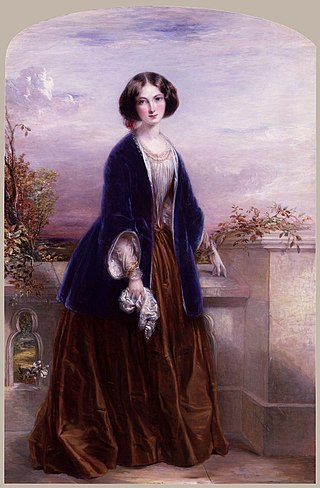
Euphemia Chalmers Millais, Lady Millais was a Scottish artists' model and the wife of Pre-Raphaelite painter John Everett Millais. She had previously been married to the art critic John Ruskin, but she left him with the marriage never having been consummated; it was subsequently annulled. This famous Victorian "love triangle" has been dramatised in plays, films, and an opera.

Sir John Everett Millais, 1st Baronet, was an English painter and illustrator who was one of the founders of the Pre-Raphaelite Brotherhood. He was a child prodigy who, aged eleven, became the youngest student to enter the Royal Academy Schools. The Pre-Raphaelite Brotherhood was founded at his family home in London, at 83 Gower Street. Millais became the most famous exponent of the style, his painting Christ in the House of His Parents (1849–50) generating considerable controversy, and he produced a picture that could serve as the embodiment of the historical and naturalist focus of the group, Ophelia, in 1851–52.

The Pre-Raphaelite Brotherhood was a group of English painters, poets, and art critics, founded in 1848 by William Holman Hunt, John Everett Millais, Dante Gabriel Rossetti, William Michael Rossetti, James Collinson, Frederic George Stephens and Thomas Woolner who formed a seven-member "Brotherhood" modelled in part on the Nazarene movement. The Brotherhood was only ever a loose association and their principles were shared by other artists of the time, including Ford Madox Brown, Arthur Hughes and Marie Spartali Stillman. Later followers of the principles of the Brotherhood included Edward Burne-Jones, William Morris and John William Waterhouse.

John Gould was an English ornithologist. He published a number of monographs on birds, illustrated by plates produced by his wife, Elizabeth Gould, and several other artists, including Edward Lear, Henry Constantine Richter, Joseph Wolf and William Matthew Hart. He has been considered the father of bird study in Australia and the Gould League in Australia is named after him. His identification of the birds now nicknamed "Darwin's finches" played a role in the inception of Darwin's theory of evolution by natural selection. Gould's work is referenced in Charles Darwin's book, On the Origin of Species.

Sir Edwin Henry Landseer was an English painter and sculptor, well known for his paintings of animals – particularly horses, dogs, and stags. However, his best-known works are the lion sculptures at the base of Nelson's Column in Trafalgar Square.

Ophelia is an 1851–52 painting by British artist Sir John Everett Millais in the collection of Tate Britain, London. It depicts Ophelia, a character from William Shakespeare's play Hamlet, singing before she drowns in a river.
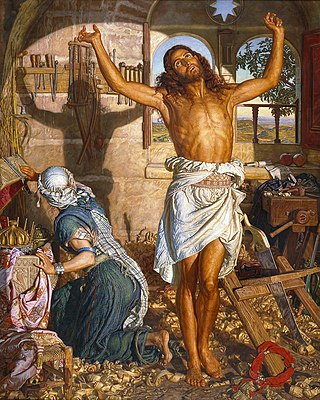
The Shadow of Death is a religious painting by William Holman Hunt, on which he worked from 1870 to 1873, during his second trip to the Holy Land. It depicts Jesus as a young man prior to his ministry, working as a carpenter. He is shown stretching his arms after sawing wood. The shadow of his outstretched arms falls on a wooden spar on which carpentry tools hang, creating a "shadow of death" prefiguring the crucifixion. His mother Mary is depicted from behind, gazing up at the shadow, having been looking into a box in which she has kept the gifts given by the Magi.

Bubbles, originally titled A Child's World, is an 1886 painting by Sir John Everett Millais that became famous when it was used over many generations in advertisements for Pears soap. During Millais's lifetime it led to widespread debate about the relationship between art and advertising.

A Dream of the Past: Sir Isumbras at the Ford (1857) is a painting by John Everett Millais depicting a medieval knight helping two young peasant children over a swollen river. The children are carrying heavy burdens of wood for winter fuel. Though the title refers to the medieval poem Sir Isumbras, the painting does not illustrate a scene from the original text. However Millais's friend, the writer Tom Taylor, wrote verse in a pastiche of the original poem, describing the event depicted. This was included in the original exhibition catalogue.
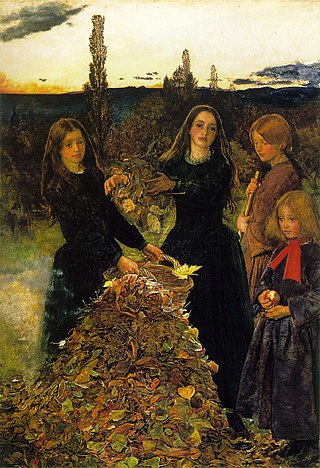
Autumn Leaves (1856) is a painting by John Everett Millais exhibited at the Royal Academy in 1856. It was described by the critic John Ruskin as "the first instance of a perfectly painted twilight." Millais's wife Effie wrote that he had intended to create a picture that was "full of beauty and without a subject".
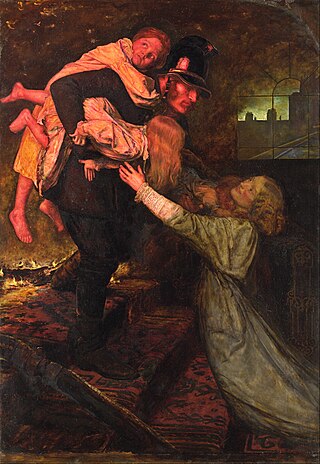
The Rescue (1855) is a painting by John Everett Millais depicting a fireman rescuing three children from a house fire, with their mother receiving them back into her arms.

Mariana is an 1851 oil-on-panel painting by John Everett Millais. The image depicts the solitary Mariana from William Shakespeare's Measure for Measure, as retold in Tennyson's 1830 poem "Mariana". The painting is regarded as an example of Millais's "precision, attention to detail, and stellar ability as a colorist". It has been held by Tate Britain since 1999.
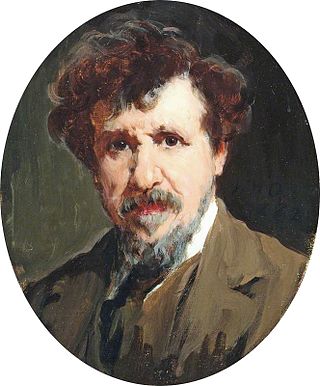
Thomas Oldham Barlow was an English mezzotint engraver. His prints helped to popularise the works of painters like John Phillip and Sir John Everett Millais.

Fancy pictures are a sub-genre of genre paintings in 18th-century English art, featuring scenes of everyday life but with an imaginative or storytelling element, usually sentimental. The usage of the term varied, and there was often an overlap with the conversation piece, a type of group portrait showing the subjects engaged in some activity.
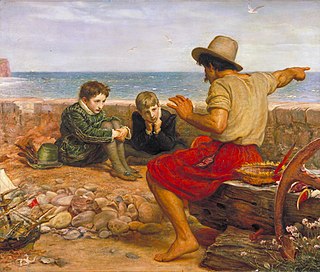
The Boyhood of Raleigh is an 1870 painting by John Everett Millais in the collection of the Tate Gallery. In the painting, Millais depicts famed Elizabethan-era explorer Walter Raleigh and his brother on the Devonshire coast listening to a Genoese sailor pointing out to sea and telling the pair of "tales of wonder on sea and land".

John Guille Millais was a British artist, naturalist, gardener and travel writer who specialised in wildlife and flower portraiture. He travelled extensively around the world in the late Victorian period detailing wildlife often for the first time. He is noted for illustrations that are of a particularly exact nature.

Louise Jane Jopling was an English painter of the Victorian era, and one of the most prominent female artists of her generation.

The Black Brunswicker (1860) is a painting by John Everett Millais. It was inspired in part by the exploits of the Black Brunswickers, a German volunteer corps of the Napoleonic Wars, during the Waterloo campaign and in part by the contrasts of black broadcloth and pearl-white satin in a moment of tender conflict.

The North-West Passage is an 1874 painting by John Everett Millais. It depicts an elderly sailor sitting at a desk, with his daughter seated in a stool beside him. He stares out at the viewer, while she reads from a log-book. On the desk is a large chart depicting complex passageways between incompletely charted islands.

Thomas Carlyle is an unfinished portrait of the Scottish essayist, historian and philosopher of the same name by English Pre-Raphaelite painter John Everett Millais in 1877.




















